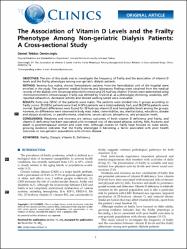The Association of Vitamin D Levels and the Frailty Phenotype Among Non-geriatric Dialysis Patients: A Cross-sectional Study
Özet
OBJECTIVES: The aim of this study was to investigate the frequency of frailty and the association of vitamin D levels and the frailty phenotype among non-geriatric dialysis patients. METHOD: Seventy-four stable, chronic hemodialysis patients from the hemodialysis unit of the hospital were enrolled in the study. The patients’ medical histories and laboratory findings were obtained from the medical records of the dialysis unit. Serum parathyroid hormone and 25-hydroxy vitamin D levels were determined using chemiluminometric immunoassays. Frailty was defined by Fried et al. as a phenotype; shrinking, weakness, selfreported exhaustion, decreased activity and slowed walking speed were evaluated. RESULTS: Forty-one (55%) of the patients were males. The patients were divided into 3 groups according to frailty scores: 39 (53%) patients were frail, 6 (8%) patients were intermediately frail, and 28 (39%) patients were normal. Significant differences were found for 25-hydroxy vitamin D and hemoglobin levels among the groups; however, no differences Q1 were observed in body mass index, comorbidities, sex, marital status, education, disease and dialysis durations, or parathormone, creatinine, serum calcium, phosphorus, and potassium levels. CONCLUSIONS: Weakness and slowness are serious outcomes of both vitamin D deficiency and frailty, and vitamin D deficiency has been associated with increased risks of decreased physical activity, falls, fractures and death in postmenopausal women and older men. Although studies on frailty have focused on older adults, growing evidence indicates that the frailty phenotype is becoming a factor associated with poor health outcomes in non-geriatric populations with chronic disease.
Cilt
73Bağlantı
http://hdl.handle.net/11363/1089Koleksiyonlar
Aşağıdaki lisans dosyası bu öğe ile ilişkilidir:


















